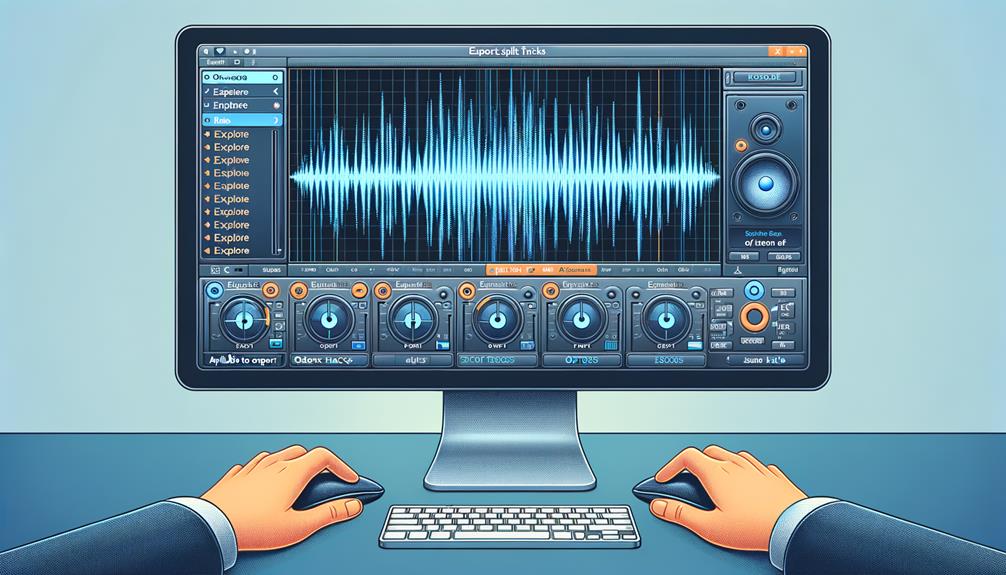No products in the cart.
When it comes to splitting tracks in Audacity, it’s like dissecting a musical puzzle to reveal its individual pieces.
But before you start slicing and dicing, it’s crucial to understand the precise techniques and tools that Audacity offers for this task.
Maybe you’ve been struggling with messy transitions or need to clean up a recording for a professional project. Either way, mastering the art of splitting tracks in Audacity can make all the difference in achieving a polished and seamless audio experience.
So, let’s unravel the intricacies of this process and explore how to navigate the editing landscape to unlock the full potential of your audio recordings.
Contents
hide
Key Takeaways
- Splitting tracks in Audacity is essential for efficient editing.
- Use the Label Track to mark the points where you want to separate the recording.
- Export the labeled sections as separate files using the Export Multiple option.
- Properly label all individual tracks for easy organization.
Understanding Audio Splitting in Audacity
To split audio tracks in Audacity, follow these precise steps to separate the recording into individual sections for further editing and manipulation.
Understanding audio splitting in Audacity is crucial for efficient editing. When you record audio in Audacity, the entire recording is saved as one file, making it essential to split the tracks for individual editing.
To split tracks, use the Label Track to mark the points where you want to separate the recording into different sections. After labeling the areas, go to the Project menu and select ‘Edit Labels’ to add labels. Then, click on ‘Tracks’ and choose ‘Add Label at Selection’ or use the shortcut Ctrl + B. This will create labels at the selected points.
Once the labels are in place, go to the File menu and select ‘Export’ then ‘Export Multiple.’ In the Export Multiple dialogue box, choose the format and other export options. Finally, click ‘Export’ to save the individual labeled sections as separate files.
Understanding this process is essential for efficient audio editing and manipulation in Audacity.
Selecting and Marking Track Boundaries
When marking track boundaries in Audacity, consider using the Selection tool to precisely indicate the start and end of each track in the recording. This tool allows for accurate selection of regions in the audio. To effectively mark track boundaries, you can use the Skip to Start button to navigate to the beginning of the track, ensuring precise marking. Additionally, adding labels at the selection for each track can help in organizing and separating them effectively. This enables easy identification and management of different sections within the recording. Furthermore, checking the box for normalizing stereo channels independently may be necessary before maximizing the volume of the recording to ensure balanced audio levels. Once the track boundaries are accurately marked, you can use the Export Multiple option to split the recording into individual audio files based on the marked track boundaries.
| Step | Description |
|---|---|
| 1. | Use the Selection tool to mark the start and end of each track. |
| 2. | Navigate to the beginning of the track using the Skip to Start button for precise marking. |
| 3. | Add labels at the selection for each track to organize and separate them effectively. |
| 4. | Check the box for normalizing stereo channels independently if needed before maximizing the volume of the recording. |
| 5. | Use the Export Multiple option to split the recording into individual audio files based on the marked track boundaries. |
Executing the Track Splitting Process

You can efficiently execute the track splitting process by using Audacity’s editing techniques to separate the recording into individual tracks. Once you have marked the track boundaries, navigate to the ‘Tracks’ menu and select ‘Add Label at Selection’ to add labels to the individual songs for organization.
To ensure uniformity in volume, consider normalizing the stereo channels using the ‘Normalize’ effect. If there’s any unwanted audio between tracks, use the time shift tool to remove it.
Additionally, if you want to insert desired gaps between songs when burning the CD, you can add silence using the ‘Generate’ menu. To achieve a smooth transition between tracks, you may consider applying the ‘Fade Out’ effect or ‘Studio Fade Out’ from the ‘Effect’ menu.
Finally, listen to the results and make any necessary adjustments before exporting the tracks. When exporting, ensure that you choose the option to export multiple files, so each track is saved individually.
Following these steps will allow you to efficiently split tracks and prepare them for further processing or distribution.
Managing Split Tracks in Audacity
Optionally, start by ensuring that all individual tracks are properly labeled for easy organization and management within Audacity. Properly labeled tracks will help you keep track of the audio content and easily navigate through the project.
Audacity provides various features for managing split tracks. You can use the Label Tracks feature to mark specific points within the audio file, making it easier to identify the beginning and end of each track. This is especially useful when working with long recordings that contain multiple songs or segments.
Additionally, you can use the Export feature to save each split track as a separate audio file. This allows you to create individual files for each track, making it easier to share or work with them in other audio editing software.
Furthermore, you can use the Normalize feature to standardize the volume level across all the split tracks, ensuring a consistent playback experience.
Finally, you can use the Playback position feature to quickly navigate to specific points within the tracks, facilitating efficient editing and management.
Exporting Split Tracks From Audacity


To export split tracks from Audacity, follow these steps:
- Click on File and select Export Audio when you’re ready to proceed.
- Choose the folder location and export format for the split tracks. For instance, select 16-bit WAV for high-quality CD burning or MP3 for digital players.
- Make sure to check the ‘Labels’ option under ‘Split Files Based On’ to ensure that each labeled section is exported as a separate song. This ensures that the split tracks are properly exported as individual files.
- You can also add track titles and other metadata using the Metadata Editor before exporting.
- Once you have set the export options, click OK to confirm the export.
- It’s important to consider online backup or storage options for the exported WAV or MP3 files to prevent data loss.
- After exporting, you can further enhance the tracks by using Audacity’s features such as amplifying, equalizing, or adding effects.
Frequently Asked Questions
How Do I Split One Track Into Two in Audacity?
To split one track into two in Audacity, use track splitting techniques and audio editing tips. Create separate tracks by cutting and splitting the audio. Manage tracks effectively in your editing workflow and master the segmentation process for efficient track separation methods.
How Do I Split Two Audio Tracks?
To split two audio tracks in Audacity, use advanced audio editing techniques. Utilize track separation, editing tools, and sound manipulation for precise segment extraction. Employ track management and slicing techniques for seamless track arrangement and audio manipulation.
How Do You Split Stems in Audacity?
To split stems in Audacity, use the audio editing tools to perform track division, waveform splitting, and segment extraction. This allows for precise sound manipulation, track isolation, and clip separation, enabling signal partitioning and file splitting.
How Do You Split and Move Tracks in Audacity?
To manipulate tracks in Audacity, you can perform precise audio editing by employing advanced splitting techniques. This involves cutting, separating, and repositioning segments to arrange and manipulate the sound for desired clip division and segment repositioning.
Conclusion
In conclusion, splitting tracks in Audacity is a straightforward process that allows for precise editing and organization of audio recordings.
By utilizing the editing tools, marking track boundaries, and utilizing effects, users can easily split and manage their tracks in Audacity.
With the ability to export the split tracks as separate audio files, Audacity provides a comprehensive solution for audio splitting needs.




